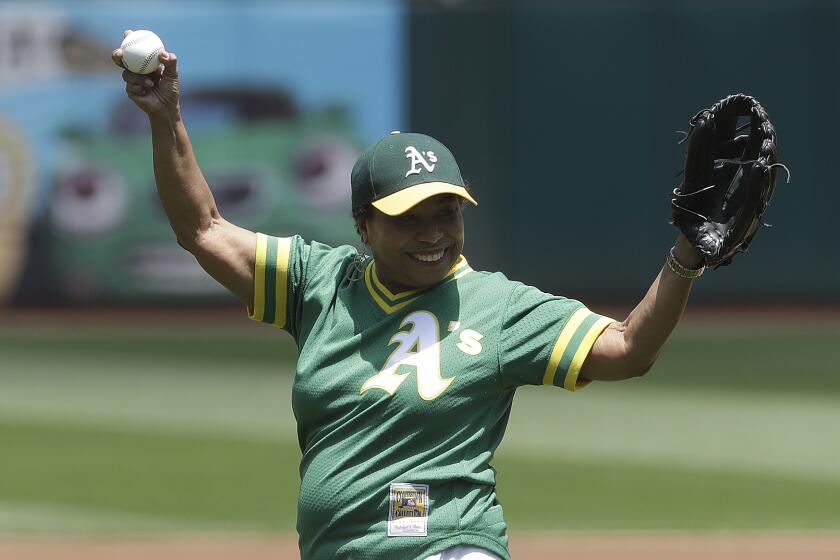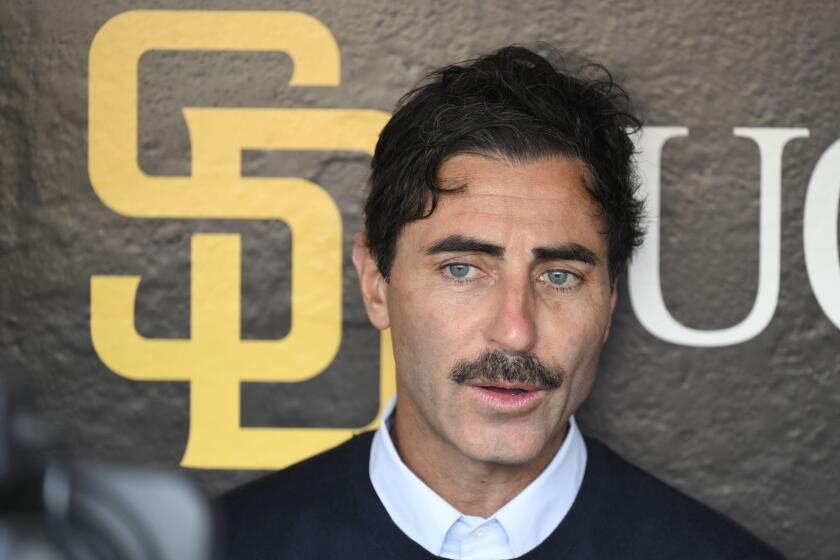A Game Paddling Against the Tide
As niche games go, table tennis in the United States does not yet have the cachet -- or the big stakes -- of televised poker.
But to hundreds of aficionados who descended on this capital of long odds and sweet dreams last week for the USA Table Tennis Assn. national championships, pingpong is the sport of choice. To hear them talk, table tennis is the ultimate game of merit in which the young can play the old, the able-bodied the disabled, and all ethnic groups seem to excel.
“I love the democratic aspect of it,” said Fran Guidry, a 58-year-old self-described “retired computer nerd” from Walnut Creek in Northern California. He has been playing for a year and a half and said he lost 20 pounds when he first took up the sport. “It’s a game where 9-year-olds play 70-year-olds. It’s a lot of fun, and you’re dripping sweat in 15 minutes.”
At the Las Vegas Convention Center, where the tournament was held, the familiar turned colossal. There were 96 tables -- according to sponsor Butterfly, which makes pingpong tables -- set up so that 800 players could compete in 4,000 matches in 60 categories over four days. Vendors lined the walls. Glue tables were set up outside, where players could add rubber to their paddles, the better for strategic spin.
At table 32 on Friday morning, 83-year-old Gerald Ryan, a retired CPA from Lake Havasu, Ariz., was battling 9-year-old Ellen Hwang of Thousand Oaks in the under-1,000 category, a rating for beginners. From the sidelines, Ellen’s father applauded her every spirited smash -- which averaged 60 mph and seemed almost impossible to return.
Ryan, who at one time was the fifth-ranked player in California, stopped playing for 40 years, until 2003, when he took up his paddle again. On Friday, he scowled. This match was fiercely fought and highly competitive. Eventually, he won.
“She hits on both sides,” Ryan said admiringly after the match, adding that he “took advantage of her height and made her chase the ball.”
Greg Cox, a scout for Butterfly sitting on the sidelines, was impressed with Ellen’s game. “If she sticks with it, she has a future,” he said.
But, being an American, that future isn’t what it might be. Table tennis may be huge in China and Sweden, in South Korea and Taiwan. But here, at the national championships for U.S. citizens, the purse for the elite players -- such as Ilija Lupulesku of Chicago and Gao Jun of Gaithersburg, Md. -- was modest. An ESPN crew showed up Thursday to do a TV spot, but there was no live coverage, no autograph-seeking fans.
Tim Boggan, 74, thinks he knows why: “We don’t have the prize money or the iconic figure like chess had in Bobby Fischer many years ago.” A former English professor at Long Island University in Brooklyn, Boggan is writing a multivolume history of the U.S. Table Tennis Assn.
The game has always attracted immigrant players, Boggan said. “On the whole, it’s a marvelously international game.”
And, since 1988, it has been an Olympic sport -- one in which players from China and South Korea dominate.
For years, play of the game in the U.S. was sponsored by Parker Bros., which owns the name Ping-Pong. In 1930, the game company held the first American Ping-Pong Tournament “in a swanky hotel in New York City with tuxedoed officials,” Boggan said.
Parker Bros., he said, was willing to underwrite the entire cost of the tournament if players used its equipment. Hard to believe in this age of Nike insignias worn by name players in many sports, but the individualists of table tennis declined, splitting off to form their own organization. Because Parker Bros. owned the name Ping-Pong, the rebels called themselves the New York Table Tennis Assn. Ever since, the sport has suffered for sponsors, and has appealed to iconoclasts.
“The old saw is that Ping-Pong is a game and that what we play is a sport,” said Art Paolini, 65, from Allentown, Pa., who’s been playing for 50 years.
Cox, representing Butterfly, agreed. “The game Ping-Pong is huge -- at fire departments, recreation halls, college dorms,” he said. “But as a sport, there’s about 3,000 active players.”
One of them is Andrew Wai, 58, who works for the Department of Water and Power in Los Angeles. The DWP, he says, has set up tables for employees who want to play at lunchtime or after work. Wai, who used to play in high school in Hong Kong, likes the workout he gets from table tennis. “I don’t like the gym, and I’m too old for soccer,” he said.
Another player is Stuart Caplin, of Jacksonville, Fla., 55, who got polio as a child. His disability did not hamper his ability to play -- he learned the game early, because “my father had a table in the basement and used to play us for our allowance every week.” Eight years ago, he suffered post-polio syndrome and now needs to use a wheelchair. Now he plays disabled table tennis, wheelchair division.
Also, there is Ariel Hsing from California, a 9-year-old wearing a T-shirt with her name, said she wanted to play in the Olympics. Six-year-old Ethan Chua’s father, Gerry, a grape farmer from Bakersfield, built a $40,000 table tennis facility on his property. There is Mohammad Owais, a 30-year-old manager of a Stop N Shop in Sturbridge, Mass., who won two nationals in Pakistan before coming to America in 2000. Owais, who also had polio, plays in the disabled, standing category.
And then there is Thelma “Tybie” Sommer, an 80-year-old from Scottsdale, Ariz., who started playing when she was 17 and still has 20/30 eyesight, which she said was excellent for table tennis.
She practices every Tuesday, Thursday and Friday, disparages the “junk rubber” that younger players glue onto their paddles to improve control and speaks fondly of her sister, Leah Neuberger, who won the 1956 world championship in mixed doubles.
Sommer proudly points to her pinkie finger, where she wears an engagement ring that she inherited when her sister died. The ring has many diamonds, in the shape of two paddles.
The table tennis historian Boggan, who wears a gold earring in the shape of a paddle, surveyed the varied players and smiled.
“This sport is a great leveler,” he said. “You could be playing with brain surgeons or pimps. And it’s kind of addictive.”
More to Read
Go beyond the scoreboard
Get the latest on L.A.'s teams in the daily Sports Report newsletter.
You may occasionally receive promotional content from the Los Angeles Times.










